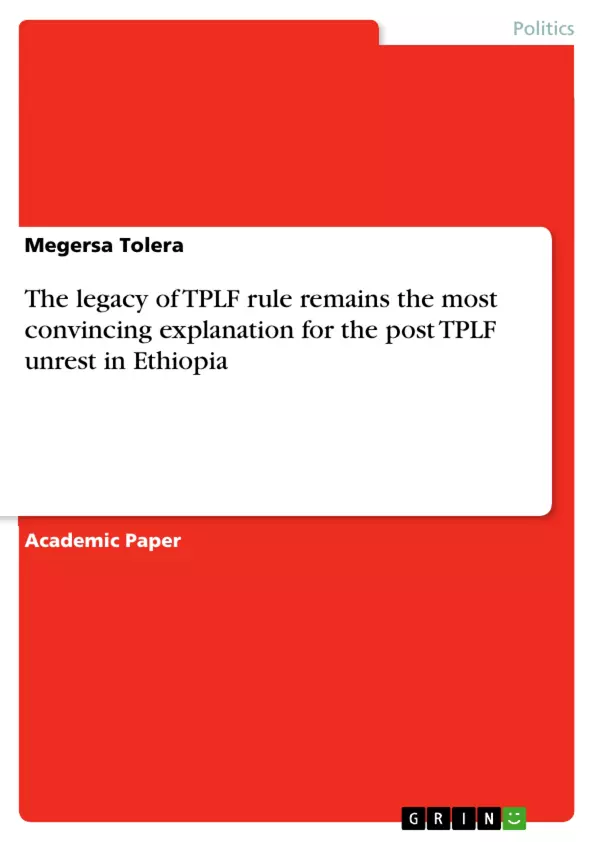To an extent, the tragedy of South Sudan since independence is a consequence of colonialism. Under the colonial state, South Sudanese were subjects divided into chiefdoms with a fusion of legislative, executive, and judicial powers conferred from the colonial state to the ethnic fiefdoms. The colonial administration used a form of ethnic federalism, aligning cultural and political boundaries, to manage native populations, not dissimilar to the approaches of Ethiopia and Nigeria today. Systems of ethnic federalism align identity and territorial divides creating options for more local autonomy while still leaving room for manoeuvring by the federal government.
Inhaltsverzeichnis (Table of Contents)
- The legacy of TPLF rule remains the most convincing explanation for the post TPLF unrest in Ethiopia
- The South Sudanese tragedy
- The legacy of colonialism
- The role of ethnicity
- The case of Rwanda
- The “Hamitic hypotheses”
- Ethiopian history
- The rise of the federal system
- The 1974 Revolution
- The Tigray People's Liberation Front (TPLF)
- The demise of TPLF rule
- The post-TPLF political process
- The legacy of colonialism in Ethiopia
Zielsetzung und Themenschwerpunkte (Objectives and Key Themes)
This article aims to examine the roots of political and social unrest in Ethiopia, focusing on the legacy of TPLF rule and the lasting impact of colonialism on the country's socio-political landscape.
- The role of colonialism in shaping ethnic divisions and tensions in Ethiopia.
- The impact of the TPLF's socio-ethnic policies on the current political climate.
- The legacy of the 1974 revolution and its implications for contemporary Ethiopian politics.
- The importance of social reconciliation and political reform in the post-TPLF era.
- The ongoing challenges and opportunities for a peaceful and democratic transition in Ethiopia.
Zusammenfassung der Kapitel (Chapter Summaries)
- The legacy of TPLF rule remains the most convincing explanation for the post TPLF unrest in Ethiopia: This section explores the lasting impact of the TPLF's policies on the country's current political and social climate, arguing that their rule has contributed significantly to the ongoing unrest.
- The South Sudanese tragedy: This section discusses the role of colonialism in shaping the political landscape of South Sudan, highlighting the legacy of ethnic divisions and tensions created during the colonial period.
- The legacy of colonialism: This section delves into the impact of colonialism on the African continent, examining the role of race theory and the concept of ethnicity in shaping colonial administration and policies.
- Ethiopian history: This section explores the history of Ethiopia, focusing on the development of the federal system and the 1974 revolution, offering insights into the country's political evolution.
- The Tigray People's Liberation Front (TPLF): This section examines the rise and influence of the TPLF, tracing their journey from a regional movement to a national power and highlighting their role in Ethiopian politics.
- The demise of TPLF rule: This section analyzes the factors leading to the downfall of the TPLF regime, exploring the popular discontent and challenges they faced during their rule.
- The post-TPLF political process: This section discusses the complex political landscape in the wake of the TPLF's departure, focusing on the need for political and social reconciliation and the challenges of building a peaceful and democratic future.
- The legacy of colonialism in Ethiopia: This section examines the lasting impact of colonialism on Ethiopia, highlighting its influence on the country's ethnic divisions, political structures, and ongoing challenges to social harmony.
Schlüsselwörter (Keywords)
Key terms and topics explored in this article include the legacy of colonialism, ethnic federalism, TPLF rule, the 1974 revolution, political unrest, social reconciliation, and the challenges of building a peaceful and democratic Ethiopia.
- Arbeit zitieren
- Mr Megersa Tolera (Autor:in), 2020, The legacy of TPLF rule remains the most convincing explanation for the post TPLF unrest in Ethiopia, München, GRIN Verlag, https://www.grin.com/document/955774



